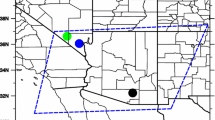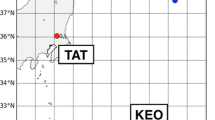Abstract
Over the past few decades, substantial progress has been made in the retrieval of surface shortwave radiation from satellite measurements for the Earth’s energy budget as well as solar energy applications. We present a new algorithm to derive the downwelling surface shortwave radiation for the Southwestern US using geostationary satellite products. A look-up table generated by the Goddard Space Flight Center Radiative Transfer Model is employed to derive the shortwave radiation at the ground by comparing observed and modeled top of atmosphere shortwave albedo. The algorithm was compared to ground observation stations at three locations, such as the University of Arizona, the University of Nevada, Las Vegas, and Desert Rock, NV. For all sky conditions, the average values of root-mean-square error between the instantaneous estimates and in situ measurements ranged from 84.2 to 89.4 W m−2 and were 30 W m−2 when evaluated on daily time scales. The error statistics were considerably better for clear sky than for cloudy sky. The average values of instantaneous root-mean-square error for the clear-sky conditions range from 39.4 to 43.7 W m−2, while average root-mean-square error for the cloudy-sky conditions is between 137.0 and 141.2 W m−2.















Similar content being viewed by others
References
Adams, D. K. and A. C. Comrie, 1997: The North American Monsoon. Bull. Amer. Meteor. Soc., 78, 2197–2213.
Almeida, M. P., R. Zilles, and E. Lorenzo, 2014: Extreme overirradiance events in São Paulo, Brazil. Solar Energy, 110, 168–173.
Andreas, A. and T. Stoffel, 2006: University of Nevada (UNLV): Las Vegas, Nevada (Data); NREL Report No. DA-5500-56509. doi:10.5439/1052548.
Andreas, A. and S. Wilcox, 2010: Observed Atmospheric and Solar Information System (OASIS); Tucson, Arizona (Data); NREL Report No. DA-5500-56494. doi:10.5439/1052226.
Augustine, J. A., G. B. Hodges, C. R. Cornwall, J. J. Michalsky, and C. I. Medina, 2005: An Update on SURFRAD—The GCOS Surface Radiation Budget Network for the Continental United States. J. Atmos. Oceanic Technol., 22, 1460–1472.
Cano, D., J. M. Monget, M. Albuisson, H. Guillard, N. Regas, and L. Wald, 1986: A method for the determination of the global solar radiation from meteorological satellite data. Solar Energy, 37, 31–39.
Chou, M.-D. and M. J. Suarez, 1999: A solar radiation parameterization for atmospheric studies. NASA/TM 1999-104606, 65 pp.
Chow, C. W., B. Urquhart, M. Lave, A. Dominguez, J. Kleissl, J. Shields, and B. Washom, 2011: Intra-hour forecasting with a total sky imager at the UC San Diego solar energy testbed. Solar Energy, 85, 2881–2893.
CREC, 2013: California Renewable Energy Forecasting, Resource Data and Mapping. Final Report BOA-99-248-R.
Dedieu, G., P. Y. Deschamps, and Y. H. Kerr, 1987: Satellite Estimation of Solar Irradiance at the Surface of the Earth and of Surface Albedo Using a Physical Model Applied to Metcosat Data. J. of Climat. and Appl. Meteor., 26, 79–87.
Gautier, C., G. Diak, and S. Masse, 1980: A Simple Physical Model to Estimate Incident Solar Radiation at the Surface from GOES Satellite Data. J. Appl. Meteor., 19, 1005–1012.
Geiger, B., C. Meurey, D. Lajas, L. Franchistéguy, D. Carrer, and J.-L. Roujean, 2008: Near real-time provision of downwelling shortwave radiation estimates derived from satellite observations. Meteor. Appl., 15, 411–420.
Gupta, S. K., N. A. Ritchey, A. C. Wilber, C. H. Whitlock, G. G. Gibson, and P. W. Stackhouse, 1999: A Climatology of Surface Radiation Budget Derived from Satellite Data. J. Climate, 12, 2691–2710.
Hay, J. E. and K. J. Hanson, 1978: Satellite-based methodology for determining solar irradiance at the ocean surface during GATE. Bull. Amer. Meteor. Soc., 59, 1549.
Hu, Y., B. A. Wielicki, P. Yang, P. W. Stackhouse, Jr., B. Lin, and D. F. Young, 2004: Application of deep convective cloud albedo observation to satellite-based study of the terrestrial atmosphere: monitoring the stability of spaceborne measurements and assessing absorption anomaly. IEEE Transactions on Geoscience and Remote Sensing, 42, 2594–2599.
Ineichen, P., C. S. Barroso, B. Geiger, R. Hollmann, A. Marsouin, and R. Mueller, 2009: Satellite Application Facilities irradiance products: hourly time step comparison and validation over Europe. International Journal of Remote Sensing, 30, 5549–5571.
Jedlovec, G. J., S. L. Haines, and F. J. LaFontaine, 2008: Spatial and Temporal Varying Thresholds for Cloud Detection in GOES Imagery. IEEE Transactions on Geoscience and Remote Sensing, 46, 1705–1717.
Kim, C. K., M. Leuthold, W. F. Holmgren, A. D. Cronin, and E. A. Betterton, 2015: Improved solar irradiance forecasts: modeling shallow cumulus clouds in the planetary boundary layer. Pure Appl. Geophys., doi:10.1007/s00024-015-1072-3.
Kleissl, J., 2013: Solar Energy Forecasting and Resource Assessment, Academic Press, 504 pp.
Li, Z. and H. G. Leighton, 1993: Global climatologies of solar radiation budgets at the surface and in the atmosphere from 5 years of ERBE data. J. of Geophy. Res., 98, 4919–4930.
Loeb, N. G., N. Manalo-Smith, S. Kato, W. F. Miller, S. K. Gupta, P. Minnis, and B. A. Wielicki, 2003: Angular Distribution Models for Top-of-Atmosphere Radiative Flux Estimation from the Clouds and the Earth’s Radiant Energy System Instrument on the Tropical Rainfall Measuring Mission Satellite. Part I: Methodology. J. Appl. Meteor., 42, 240–265.
Ma, Y. and R. T. Pinker, 2012: Modeling shortwave radiative fluxes from satellites. J. of Geophy. Res., 117, D23202.
Marty, C., R. Philipona, C. Fröhlich, and A. Ohmura, 2002: Altitude dependence of surface radiation fluxes and cloud forcing in the alps: results from the alpine surface radiation budget network. Theor. and Appl. Climato., 72, 137–155.
Miller, S. D., A. K. Heidinger, M. Sengupta, and J. Kleissl, 2013: Chapter 3—Physically Based Satellite Methods. Solar Energy Forecasting and Resource Assessment, Academic Press, 49–79.
Minnis, P. and E. F. Harrison, 1984: Diurnal Variability of Regional Cloud and Clear-Sky Radiative Parameters Derived from GOES Data. Part III: November 1978 Radiative Parameters. J. of Climat. and Appl. Meteor., 23, 1032–1051.
Minnis, P., W. L. S. Jr, D. P. Garber, J. K. Ayers, and D. R. Doelling, 1995: Cloud Properties Derived From GOES-7 for Spring 1994 ARM Intensive Observing Period Using Version 1.0.0 of ARM Satellite Data Analysis Program.
Möser, W. and E. Raschke, 1984: Incident Solar Radiation over Europe Estimated from METEOSAT Data. J. of Climat. and Appl. Meteor., 23, 166–170.
NREL, 2012: U.S. Department of Energy Workshop Report: Solar Resources and Forecasting Technical Report NREL/TP-5500-55432.
Otkin, J. A., M. C. Anderson, J. R. Mecikalski, and G. R. Diak, 2005: Validation of GOES-Based Insolation Estimates Using Data from the U.S. Climate Reference Network. J. of Hydrometeor., 6, 460–475.
Perez, R., P. Ineichen, K. Moore, M. Kmiecik, C. Chain, R. George, and F. Vignola, 2002: A new operational model for satellite-derived irradiances: description and validation. Solar Energy, 73, 307–317.
Piedehierro, A. A., M. Antón, A. Cazorla, L. Alados-Arboledas, and F. J. Olmo, 2014: Evaluation of enhancement events of total solar irradiance during cloudy conditions at Granada (Southeastern Spain). Atmos. Res., 135–136, 1–7.
Pinker, R. T. and J. A. Ewing, 1985: Modeling Surface Solar Radiation: Model Formulation and Validation. J. of Climat. and Appl. Meteor., 24, 389–401.
Pinker, R. T. and I. Laszlo, 1992: Modeling Surface Solar Irradiance for Satellite Applications on a Global Scale. J. Appl. Meteor., 31, 194–211.
Pinker, R. T., B. Zhang, and E. G. Dutton, 2005: Do Satellites Detect Trends in Surface Solar Radiation? Science, 308, 850–854.
Pinker, R. T., J. D. Tarpley, I. Laszlo, K. E. Mitchell, P. R. Houser, E. F. Wood, J. C. Schaake, A. Robock, D. Lohmann, B. A. Cosgrove, J. Sheffield, Q. Duan, L. Luo, and R. W. Higgins, 2003: Surface radiation budgets in support of the GEWEX Continental-Scale International Project (GCIP) and the GEWEX Americas Prediction Project (GAPP), including the North American Land Data Assimilation System (NLDAS) project. J. of Geophy. Res., 108, 8844.
Poore, K. D., J. Wang, and W. B. Rossow, 1995: Cloud Layer Thicknesses from a Combination of Surface and Upper-Air Observations. J. Climate, 8, 550–568.
Prabhakar, G., E. A. Betterton, W. Conant, and B. M. Herman, 2014: Effect of Urban Growth on Aerosol Optical Depth—Tucson, Arizona, 35 Years Later. J. Appl. Meteor. and Climat., 53, 1876–1885.
Raphael, C. and J. E. Hay, 1984: An Assessment of Models which use Satellite Data to Estimate Solar Irradiance at the Earth’s Surface. J. of Climat. and Appl. Meteor., 23, 832–844.
Rigollier, C., M. Lefèvre, and L. Wald, 2004: The method Heliosat-2 for deriving shortwave solar radiation from satellite images. Solar Energy, 77, 159–169.
Rossow, W. B. and R. A. Schiffer, 1991: ISCCP Cloud Data Products. Bull. Amer. Meteor. Soc., 72, 2–20.
Rossow, W. B. and R. A. Schiffer, 1999: Advances in Understanding Clouds from ISCCP. Bull. Amer. Meteor. Soc., 80, 2261–2287.
Ruiz-Arias, J. A., J. Dudhia, F. J. Santos-Alamillos, and D. Pozo-Vázquez, 2013: Surface clear-sky shortwave radiative closure intercomparisons in the Weather Research and Forecasting model. J. of Geophy. Res., 118, 9901–9913.
Schillings, C., H. Mannstein, and R. Meyer, 2004: Operational method for deriving high resolution direct normal irradiance from satellite data. Solar Energy, 76, 475–484.
Stuhlmann, R., M. Rieland, and E. Paschke, 1990: An Improvement of the IGMK Model to Derive Total and Diffuse Solar Radiation at the Surface from Satellite Data. J. Appl. Meteor., 29, 586–603.
Tarpley, J. D., 1979: Estimating Incident Solar Radiation at the Surface from Geostationary Satellite Data. J. Appl. Meteor., 18, 1172–1181.
Tilmes, S., J. F. Lamarque, L. K. Emmons, A. Conley, M. G. Schultz, M. Saunois, V. Thouret, A. M. Thompson, S. J. Oltmans, B. Johnson, and D. Tarasick, 2012: Technical Note: Ozonesonde climatology between 1995 and 2011: description, evaluation and applications. Atmos. Chem. Phys., 12, 7475–7497.
Vignola, F., P. Harlan, R. Perez, and M. Kmiecik, 2007: Analysis of satellite derived beam and global solar radiation data. Solar Energy, 81, 768–772.
Wang, H. and R. T. Pinker, 2009: Shortwave radiative fluxes from MODIS: Model development and implementation. J. of Geophy. Res., 114, D20201.
Whitlock, C. H., T. P. Charlock, W. F. Staylor, R. T. Pinker, I. Laszlo, A. Ohmura, H. Gilgen, T. Konzelman, R. C. DiPasquale, C. D. Moats, S. R. LeCroy, and N. A. Ritchey, 1995: First Global WCRP Shortwave Surface Radiation Budget Dataset. Bull. Amer. Meteor. Soc., 76, 905–922.
Wu, X. and F. Yu, 2013: Correction for GOES Imager Spectral Response Function Using GSICS. Part I: Theory. IEEE Transactions on Geoscience and Remote Sensing, 51, 1215–1223.
Yordanov, G. H., O.-M. Midtgård, T. O. Saetre, H. K. Nielsen, and L. E. Norum, 2013: Overirradiance (Cloud Enhancement) Events at High Latitudes. IEEE Journal of Photovoltaics, 3, 271–277.
Yu, F. and X. Wu, 2013: Correction for GOES Imager Spectral Response Function Using GSICS. Part II: Applications. IEEE Transactions on Geoscience and Remote Sensing, 51, 1200–1214.
Yucel, I., W. James Shuttleworth, X. Gao, and S. Sorooshian, 2003: Short-Term Performance of MM5 with Cloud-Cover Assimilation from Satellite Observations. Mon. Wea. Rev., 131, 1797–1810.
Zelenka, A., R. Perez, R. Seals, and D. Rennè, 1999: Effective Accuracy of Satellite-Derived Hourly Irradiances. Theoretical and Applied Climatology, 62, 199–207.
Zhang, Y., W. B. Rossow, A. A. Lacis, V. Oinas, and M. I. Mishchenko, 2004: Calculation of radiative fluxes from the surface to top of atmosphere based on ISCCP and other global data sets: Refinements of the radiative transfer model and the input data. J. of Geophy. Res., 109, D19105.
Zhang, Y. C., W. B. Rossow, and A. A. Lacis, 1995: Calculation of surface and top of atmosphere radiative fluxes from physical quantities based on ISCCP data sets: 1. Method and sensitivity to input data uncertainties. J. of Geophy. Res., 100, 1149–1165.
Acknowledgments
This material is based upon work supported by Tucson Electric Power company. This work was conducted under framework of the research and development program of the Korea Institute of Energy Research (GP2014-0030).
Author information
Authors and Affiliations
Corresponding author
Rights and permissions
About this article
Cite this article
Kim, C.K., Holmgren, W.F., Stovern, M. et al. Toward Improved Solar Irradiance Forecasts: Derivation of Downwelling Surface Shortwave Radiation in Arizona from Satellite. Pure Appl. Geophys. 173, 2535–2553 (2016). https://doi.org/10.1007/s00024-016-1302-3
Received:
Revised:
Accepted:
Published:
Issue Date:
DOI: https://doi.org/10.1007/s00024-016-1302-3




